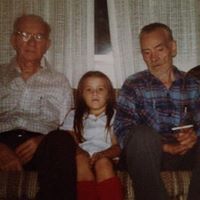Ronald F Schroeder
age ~89
from Cleveland, OH
- Also known as:
-
- Ronald E Schroeder
- Ronald F Shroeder
- Ron F Schroeder
- Nancy Schroeder
Ronald Schroeder Phones & Addresses
- Cleveland, OH
- Granville, OH
- Newark, OH
- Broadview Hts, OH
- 680 Dogwood Ln, Newark, OH 43055 • (740)3449568
Work
-
Position:Retired
Isbn (Books And Publications)

From Sensation to Society: Representations of Marriage in the Fictions of Mary Elizabeth Braddon, 1862-1866
view sourceAuthor
Ronald A. Schroeder
ISBN #
0874139449
License Records
Ronald M. Schroeder
License #:
E-1222 - Expired
Category:
Engineering Intern
Ronald K Schroeder
License #:
12734 - Expired
Category:
Emergency Medical Care
Issued Date:
Aug 28, 1998
Effective Date:
Jan 7, 2014
Expiration Date:
Dec 31, 2013
Type:
EMT
Ronald H Schroeder
License #:
4619 - Active
Category:
Water Operator
Issued Date:
Mar 24, 2015
Effective Date:
Mar 24, 2015
Expiration Date:
Dec 31, 2017
Type:
Grade IV Water Operator
Name / Title
Company / Classification
Phones & Addresses
ALLEN RUN GRAIN FARMS LLC
Manager, Sales Director
Ohio Aluminum Industries, Inc
Aluminum Foundry · Aluminum Die-Casting Foundries
Aluminum Foundry · Aluminum Die-Casting Foundries
4840 Warner Rd, Cleveland, OH 44125
(216)6418865, (216)6418847
(216)6418865, (216)6418847
Us Patents
-
Electrostatic Rotary Atomizing Spray Device With Improved Atomizer Cup
view source -
US Patent:RE38526, Jun 8, 2004
-
Filed:Sep 5, 2001
-
Appl. No.:09/947069
-
Inventors:Michael P. Hansinger - Olmsted Falls OH
Jeffrey T. Conrad - Valley City OH
Woodie R. Francis - Avon Lake OH
Harold D. Beam - Oberlin OH
Joseph J. Karbowniczek - Elyria OH
Ronald R. Schroeder - Amherst OH -
Assignee:Nordson Corporation - Westlake OH
-
International Classification:B05B 504
-
US Classification:239 3, 239224, 239580, 239600, 239703
-
Abstract:An electrostatic, liquid spray, rotary atomizer has an atomizer housing, a power supply within the housing and an atomizer cup at a front end of the housing. The atomizer cup, which is formed of a non-conductive material, has several elongate conductive pathways embedded in the body of the cup. Each conductive pathway has one end exiting an outer surface at a rear end of the cup for receiving the charge from the power supply and another end exiting an inner surface at a front end of the cup for conveying an electrical charge from the power supply to the liquid (paint) particles passing through the atomizer cup. An electrode is provided for maintaining a small voltage at the access hole. The rotary atomizer with the improved charge ring and rotary cup can be mounted to a robot and connected to the liquid supply by an elongated spiral passageway to increase the electrical resistance between the atomizer and the liquid supply so that a very small electrical charge, if any, will be present in the passageway carrying paint to the rotary cup.
-
Electrostatic Rotary Atomizing Spray Device
view source -
US Patent:56975597, Dec 16, 1997
-
Filed:Mar 15, 1995
-
Appl. No.:8/404355
-
Inventors:Dennis Davis - Bay Village OH
Harold Beam - Oberlin OH
Ronald R. Schroeder - Amherst OH
Carl Bretmersky - No. Olmsted OH
Stephen Lee Merkel - Bay Village OH
Thomas Andreas Trautzsch - Macedonia OH -
Assignee:Nordson Corporation - Westlake OH
-
International Classification:B05B 504
B05B 310 -
US Classification:239703
-
Abstract:A rotary atomizer has an internal power supply in the atomizer housing about which is passed cooling air. The air then flows out of the atomizer housing in a twisting direction as vectored air in the same direction of rotation as the atomizer head to eliminate any vacuum condition around the atomizer head and to provide shaping control of the coating being sprayed. Exhaust air from an air turbine motor driving the atomizer head is directed around the outside surface of the atomizer housing to prevent the liquid coating from wrapping back and accumulating onto the atomizer housing. A speed sensing system is mounted in the atomizer housing and utilizes both magnetics and optics for accurately measuring the rotational speed of the air turbine motor in the presence of high electrostatic charge and RF fields from the internal power supply. The power supply is disposed within the atomizer housing about the turbine motor. The atomizing head, in one embodiment, incorporates an insert which divides the flow of coating material into a plurality of individual streams to improve the atomization of the coating material from the atomizing head.
-
Electrostatic Rotary Atomizing Spray Device
view source -
US Patent:60562153, May 2, 2000
-
Filed:Apr 16, 1997
-
Appl. No.:8/834290
-
Inventors:Michael P. Hansinger - Olmsted Falls OH
Harold Beam - Oberlin OH
Dennis J. Davis - Bay Village OH
Ronald R. Schroeder - Amherst OH
Carl Bretmersky - North Olmsted OH
Stephen Lee Merkel - Bay Village OH
Thomas Andreas Trautzsch - Macedonia OH -
Assignee:Nordson Corporation - Westlake OH
-
International Classification:B05B 504
-
US Classification:239703
-
Abstract:A rotary atomizer has an internal power supply in the atomizer housing about which is passed cooling air. The air then flows out of the atomizer housing in a twisting direction as vectored air in the same direction of rotation as the atomizer head to eliminate any vacuum condition around the atomizer head and to provide shaping control of the coating being sprayed. A portion of the exhaust air from an air turbine motor driving the atomizer head with a turbine shaft is directed through a passageway between a stationary fluid tube within the turbine shaft and the rotary shaft to direct the exhaust air into the atomizer head to mix with the coating and create an air barrier that prevents coating material from leaking back into the rotary atomizer device. The remaining portion of the exhaust air from the air turbine motor is channeled around the outside surface of the housing of the rotary atomizer device to prevent liquid coating material from wrapping back and attaching to the atomizer housing.
-
Electrostatic Rotary Atomizing Spray Device With Improved Atomizer Cup
view source -
US Patent:59473770, Sep 7, 1999
-
Filed:Aug 28, 1997
-
Appl. No.:8/919831
-
Inventors:Michael P. Hansinger - Olmsted Falls OH
Jeffrey A. Conrad - Valley City OH
Woodie Francis - Avon Lake OH
Harold Beam - Oberlin OH
Joseph Jerome Karbowniczek - Elyria OH
Ronald Schroeder - Amherst OH -
Assignee:Nordson Corporation - Westlake OH
-
International Classification:B05B 504
-
US Classification:239 3
-
Abstract:An electrostatic, liquid spray, rotary atomizer has an atomizer housing, a power supply within the housing and an atomizer cup at a front end of the housing. The atomizer cup, which is formed of a non-conductive material, has several elongate conductive pathways embedded in the body of the cup. Each conductive pathway has one end exiting an outer surface at a rear end of the cup for receiving the charge from the power supply and another end exiting an inner surface at a front end of the cup for conveying an electrical charge from the power supply to the liquid (paint) particles passing through the atomizer cup. An electrode is provided for maintaining a small voltage at the access hole. The rotary atomizer with the improved charge ring and rotary cup can be mounted to a robot and connected to the liquid supply by an elongated spiral passageway to increase the electrical resistance between the atomizer and the liquid supply so that a very small electrical charge, if any, will be present in the passageway carrying paint to the rotary cup.
-
Electrostatic Rotary Atomizing Spray Device With Improved Atomizer Cup
view source -
US Patent:60534370, Apr 25, 2000
-
Filed:Apr 29, 1999
-
Appl. No.:9/301964
-
Inventors:Michael P. Hansinger - Olmsted Falls OH
Jeffrey T. Conrad - Valley City OH
Woodie Francis - Avon Lake OH
Harold Beam - Oberlin OH
Joseph Jerome Karbowniczek - Elyria OH
Ronald Schroeder - Amherst OH -
Assignee:Nordson Corporation - Westlake OH
-
International Classification:B05B 504
-
US Classification:239703
-
Abstract:An electrostatic, liquid spray, rotary atomizer has an atomizer housing, a power supply within the housing and an atomizer cup at a front end of the housing. The atomizer cup, which is formed of a non-conductive material, has several elongate conductive pathways embedded in the body of the cup. Each conductive pathway has one end exiting an outer surface at a rear end of the cup for receiving the charge from the power supply and another end exiting an inner surface at a front end of the cup for conveying an electrical charge from the power supply to the liquid (paint) particles passing through the atomizer cup. A number of conductive extensions are embedded in a frustroconical front portion of the cup. Each conductive extension has one end which is contiguous with the inner surface exiting end of selected ones of the conductive pathways, a first opposite end portion exiting an outer surface of the frustroconical front portion of the cup and a second opposite end portion exiting an inner surface of the frustroconical front portion of the cup. An annular charge ring is mounted to the front of the atomizer housing and is configured to accommodate the atomizer cup with conductive pathways and extensions and has an access hole for facilitating insertion of a tool for quickly demounting the atomizer cup for cleaning or replacement.
Lawyers & Attorneys
Resumes

Ronald Schroeder
view source
Investment Manager
view sourceWork:
Investment Manager

Ronald C Schroeder
view source
Ronald Schroeder
view source
Ronald Schroeder
view sourceLocation:
United States

Information Technology And Services Consultant And Contractor
view sourceLocation:
United States
Industry:
Information Technology and Services
Myspace
Googleplus

Ronald Schroeder

Ronald Schroeder

Ronald Schroeder

Ronald Schroeder

Ronald Schroeder
Bragging Rights:
Im happily married with four kids

Ronald Schroeder
Flickr
Plaxo

Ronald Schroeder
view sourceData Engineer at Alltel
Classmates

Ronald Schroeder
view sourceSchools:
Carson Long Military High School New Bloomfield PA 1949-1953
Community:
Jeffrey Goodiel, Joe Catalini, Rick Spina, Curtis Mathews

Ronald Schroeder
view sourceSchools:
St. Symphorosa School Chicago IL 1935-1974
Community:
Phil De Luca, Robert Kaleta, Mike Ogrady

Ronald C. Schroeder
view sourceSchools:
Appleton-Appleton West High School Appleton MN 1964-1969
Community:
Maxine Halvorson, Dave Hoppe, Robin Lokken, Janet Jenniges, Ursula Stier

Ronald Schroeder
view sourceSchools:
Detroit Lakes High School Detroit Lakes MN 1984-1988
Community:
Julie Jorgenson

Ronald Schroeder
view sourceSchools:
Flintstone High School Flintstone MD 1978-1979
Community:
Michael Schoenadel, Tom Gray, John Packard, Sherri Brown, Cheryl Walden

Ronald Sam Schroeder (Lar...
view sourceSchools:
Northwoods Seventh Day Adventist School Hutchinson MN 1995-1998
Community:
Ronald Burger, Kaisa Km, Luke Liepke, Sam Schroeder, Dustin Mitchell, Terah Heinrich

Ronald Schroeder
view sourceSchools:
Hubbard High School Chicago IL 1995-1999
Community:
Carol Leganski, Karen Krishen, Andrea Ward

Ronald Schroeder
view sourceSchools:
Antwerp High School Antwerp OH 1988-1992
Community:
Jerry Conner, Micki Speer
Youtube

Ronald Vanessa Schroeder
view source
Ronald Schroeder
view source
Ronald Schroeder
view source
Ronald Schroeder
view source
Ronald Schroeder
view source
Ronald Schroeder
view source
Ronald Paul Schroeder
view source
Ronald Schroeder
view sourceGet Report for Ronald F Schroeder from Cleveland, OH, age ~89
















